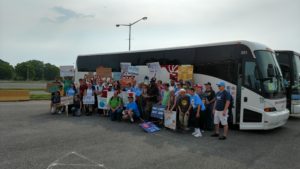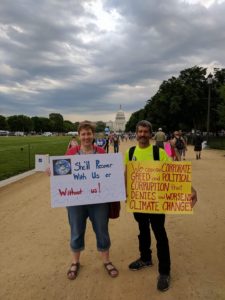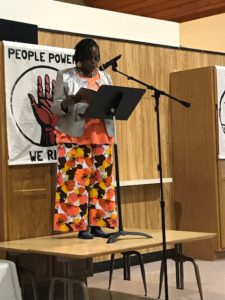By Members of Prairie Group of Sierra Club and Food & Water Watch
Origins of the People’s Climate March
By Alice Englebretsen
Alice Englebretsen has been a member of the Sierra Club for many years, and originally got involved by going on national outings. For the last 16 years she has been on the Executive Committee of the Prairie Group of the Illinois Chapter in many capacities. Currently she is Treasurer and Political Chair of the Prairie Group.
The original People’s Climate March (PCM) was called in May 2014 by 350.org, the environmental organization founded by writer/activist Bill McKibben, and it was endorsed by over 1,500 organizations, including the Sierra Club. The march was conceived as a response to the scheduled U.N. Climate Summit of world leaders to take place in New York City on September 21, 2014. The months of organizing and the day itself helped to re-boot the climate movement in this country. The march was attended by over 400,000 people from all walks of life.
The work of the PCM is grounded in a set of core principles:
- Prioritize leadership of front-line communities, communities of color, low-income communities, workers and others impacted by climate, economic and racial inequity.
- Use the Jemez Principles for Democratic Organizing to ground our work.
- Build a coordinated but decentralized structure that lifts up a common platform and message while being flexible enough to create more opportunities for connection to local issues, ownership and engagement in the movement.
- Work in a way that helps to strengthen and build the capacity of the local organizing.
- Develop opportunities for a range of organizations and social movements to work together, and to use our joint efforts to give greater visibility to our common struggle. This includes, but is not limited to, putting people into the streets as we demand policy changes and bold action.
In 2015 the Peoples Climate Movement focused its collective energy on strengthening the climate justice movement at the local level. That October we organized 200 actions in 48 locations, mostly led by front-line communities, unions, faith groups, youth, and people of color organizations. These actions highlighted the on-the-ground realities in their cities, and tied those struggles to the national movement.
In addition to the People’s Climate March in New York City, there were many other communities around the world who also hosted marches.
Alarms went off again when the climate-denying Trump was elected President in 2016, along with a right wing congress. Another People’s Climate March was organized for April 29th, 2017, 100 days after the inauguration, to be held in Washington D.C. In addition, many other communities in the United States and around the world organized marches. In Illinois there were marches held in Chicago, Carbondale, Peoria and Champaign-Urbana.
Hiking Boots on the Ground (in D.C.)
by Rachel Vellenga
Rachel Vellenga is a Sierra Club board member and children’s librarian in Urbana, IL. She enjoys hiking, reading and hanging out with her backyard chickens in her spare time. Her newest flock members are named Rea and Zist.
Equally important to the local marches was getting a large number of demonstrators to show up in D.C. to show politicians how adamant people are about the need to act on climate change. Some traveled on their own and some rode on buses organized by various environmental groups and other non-profits from around the country. An estimated 200,000 people answered the call to the national protest, people of all ages and ethnic groups.
I took a bus organized by the Illinois Chapter of the Sierra Club. The bus stopped in Peoria, Bloomington/Normal, Champaign/Urbana and Indianapolis. We were at capacity by the time we pulled out of Indianapolis, and drove all night to arrive in D.C. Saturday morning. The march was very well organized, with parking set aside for buses at RFK Stadium and volunteers to direct us how to get to the starting point. You could text a number on your cellphone to get updates about the march and messages from your fellow bus participants.
We had a few hours to explore before lining up in a predetermined order. Our location was towards the end of the march, and therefore we had to wait some time to get started. But spirits were high, and we were eager to show our support for the planet. The weather was a sweltering 90 degrees in April, a tie with the all-time record set in 1974 (appropriate for the cause – where’s James “Snowball” Inhofe when you need him). Some kids got the entrepreneur spirit and sold bottled water out of old shopping carts for the sweating masses yearning to be free (of climate change). While I am loath to buy bottled water, I am more loath to pass out on the asphalt in front of Trump Hotel from heat exhaustion (although again… appropriate).
We marched peacefully with a great collection of clever signs, costumes (one brave soul dressed in full polar bear outfit), musical instruments and chants. The biggest reaction came when we passed Trump Hotel, where marchers let our displeasure be heard loud and clear. Food trucks lined the avenue when we finished, and then it was back to our bus for the all-night ride home. We were extremely tired and sweaty and in need of a shower, but confident that we had done our part to show our support for combating climate change.
Champaign-Urbana March
By Lois Kain
Lois Kain hooked up with Food and Water Watch in the fall of 2012 for the GMO food labeling fight in Illinois, and has been the volunteer local coordinator since 2013. She went to the NYC march in 2014 and wanted to try to bring that incredible experience to C-U.
When details for the 2017 PCM were being worked out for D.C., organizers around the country expressed desires to hold events in their home towns, so, the idea of sister marches was born. Day by day the map of sister marches and events around the country grew in number. While Chicago would be Illinois’ biggest march (5,000 people hit the streets in a cold rain!), a number of other cities across the state joined in to give Illinois activists an option closer to home. Champaign-Urbana got on the map! Local members of Sierra Club and Food and Water Watch, with the help of student groups Beyond Coal and iMatter, came together to create our event.
The steering committee decided to have not only a march but an Earth fair out in the fresh air and sunshine of Westside Park in Champaign. Music, tabling with local organizations, speakers, a march, and a raffle to raise money for our very own Pollinatarium came together over the months of March and April.
Carol Ammons (State Representative) and Scott Bennett (State Senator) headed up our speaker list. Alice Englebretsen (Sierra Club), Carol Hayes (Prairie Rivers Network), Lan Richart (Eco-Justice Collaborative), and Anna Catalina Rosu (iMatter) added their voices in the call for people to WAKE UP! to the impending catastrophe of our warming planet. Environmental and political party organizations, churches, local green energy companies and the City of Urbana tabled with messages and information for us human inhabitants of Mother Earth of hope, justice, solidarity, and solutions for the social and environmental messes in which we had made for ourselves. Even Flat Rodney hung out with us! Meadowhawk provided the welcoming music and Common Ground Food Co-op and Strawberry Fields-World Harvest donated cool, Earth-loving gift baskets for the raffle.
As the date approached, the weather forecast became more and more ominous. We had to decide to change our plans or change the venue. We opted for venue and Grace Lutheran Church was gracious enough to provide the new location on such a short notice.
People from all around East Central Illinois RSVP’d on the sister march website from Danville to Peoria, and Watseka to Mount Vernon. The threatening weather and sudden venue change did not dampen the spirits of 300 Earthlings who came to share their concerns and hopes for the future of our only home, Gaia.



